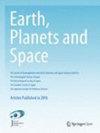Coastal tsunami prediction in Tohoku region, Japan, based on S-net observations using artificial neural network
IF 2.5
3区 地球科学
引用次数: 1
Abstract
Abstract We present a novel method for coastal tsunami prediction utilizing a denoising autoencoder (DAE) model, one of the deep learning algorithms. Our study focuses on the Tohoku coast, Japan, where dense offshore bottom pressure gauges (OBPGs), called S-net, are installed. To train the model, we generated 800 hypothetical tsunami scenarios by employing stochastic earthquake models (M7.0–8.8). We used synthetic tsunami waveforms at 44 OBPGs as input and the waveforms at four coastal tide gauges as output. Subsequently, we evaluated the model’s performance using 200 additional hypothetical and two real tsunami events: the 2016 Fukushima earthquake and 2022 Tonga volcanic tsunamis. Our DAE model demonstrated high accuracy in predicting coastal tsunami waveforms for hypothetical events, achieving an impressive quality index of approximately 90%. Furthermore, it accurately forecasted the maximum amplitude of the 2016 Fukushima tsunami, achieving a quality index of 91.4% at 15 min after the earthquake. However, the prediction of coastal waveforms for the 2022 Tonga volcanic tsunami was not satisfactory. We also assessed the impact of the forecast time window and found that it had limited effects on forecast accuracy. This suggests that our method is suitable for providing rapid forecasts soon after an earthquake occurs. Our research is the first application of an artificial neural network to tsunami prediction using real observations. In the future, we will use more tsunami scenarios for model training to enhance its robustness for different types of tsunamis. Graphical Abstract基于S-net观测的人工神经网络对日本东北地区沿海海啸的预测
摘要本文提出了一种利用深度学习算法去噪自编码器(DAE)模型进行海岸海啸预测的新方法。我们的研究重点是日本东北海岸,那里安装了密集的海上底部压力表(obpg),称为S-net。为了训练模型,我们使用随机地震模型(M7.0-8.8)生成了800个假设的海啸场景。我们使用44个obpg的合成海啸波形作为输入,并使用四个海岸潮汐计的波形作为输出。随后,我们使用200个额外的假设海啸事件和两个真实海啸事件(2016年福岛地震和2022年汤加火山海啸)来评估模型的性能。我们的DAE模型在预测假设事件的沿海海啸波形方面显示出很高的准确性,达到了令人印象深刻的约90%的质量指数。此外,它准确地预测了2016年福岛海啸的最大振幅,在地震发生15分钟后达到了91.4%的质量指数。然而,对2022年汤加火山海啸海岸波形的预测并不令人满意。我们还评估了预测时间窗的影响,发现它对预测精度的影响有限。这表明我们的方法适合在地震发生后不久提供快速预报。我们的研究是首次将人工神经网络应用于实际观测的海啸预测。在未来,我们将使用更多的海啸场景进行模型训练,以增强其对不同类型海啸的鲁棒性。图形抽象
本文章由计算机程序翻译,如有差异,请以英文原文为准。
求助全文
约1分钟内获得全文
求助全文
来源期刊

Earth, Planets and Space
地学天文-地球科学综合
CiteScore
5.80
自引率
16.70%
发文量
167
期刊介绍:
Earth, Planets and Space (EPS) covers scientific articles in Earth and Planetary Sciences, particularly geomagnetism, aeronomy, space science, seismology, volcanology, geodesy, and planetary science. EPS also welcomes articles in new and interdisciplinary subjects, including instrumentations. Only new and original contents will be accepted for publication.
 求助内容:
求助内容: 应助结果提醒方式:
应助结果提醒方式:


